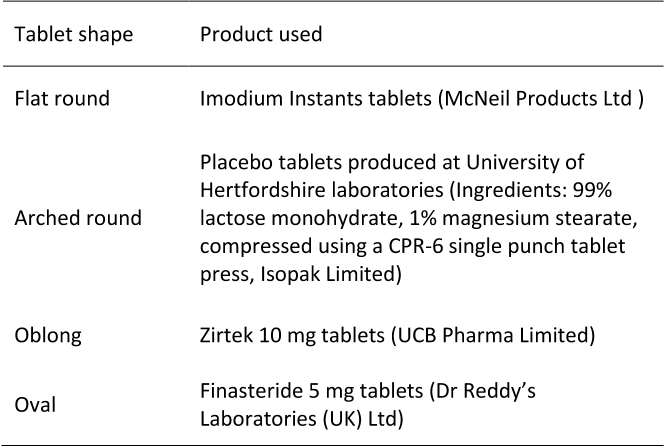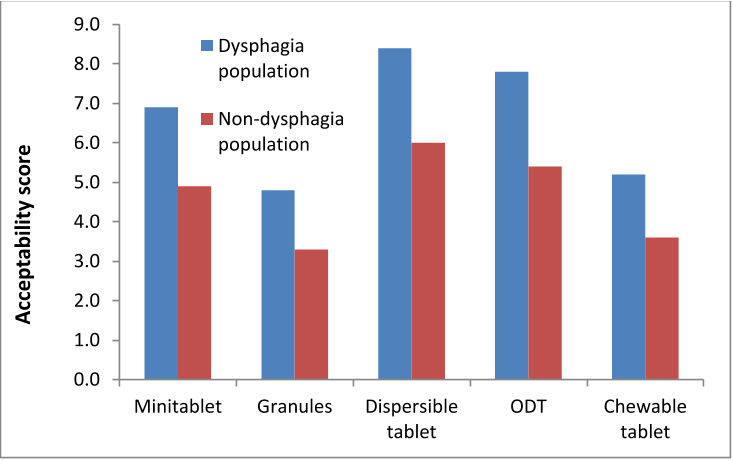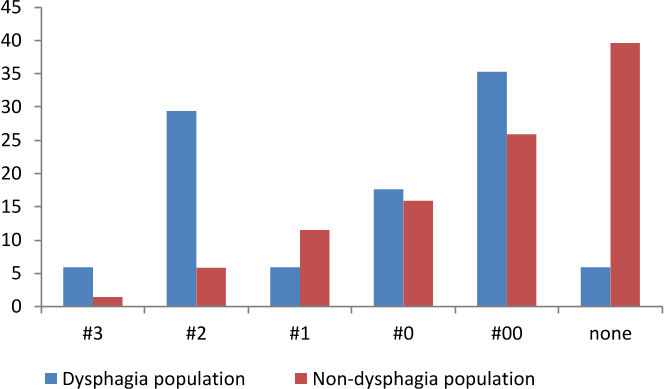Acceptability of oral solid medicines in older adults with and without dysphagia: A nested pilot validation questionnaire based observational study
TLDR
Assessment of acceptability of oral solid medicines in older ambulatory patients with and without dysphagia found that higher acceptability scores were seen in the dysphagic population than in the non-dysphagic population for all of the dosage forms that were easier to swallow than tablets and capsules.About:
This article is published in International Journal of Pharmaceutics.The article was published on 2016-10-30 and is currently open access. It has received 71 citations till now. The article focuses on the topics: Dysphagia & Population.read more
Figures

Table 1. Products used to represent 9 mm tablets in different shapes 
Table 2. Products used to represent various oral formulations 
Fig 3. Acceptability scores of different oral solid dosage forms (ODT: orally disintegrating tablet). 
Table 4. Participants’ impression on the flexible solid oral dosage forms. 2 
Figure 1. Percentage of participants selecting the tablet size and shape that started to cause difficulty in swallowing. 
Fig 2. Percentage of participants selecting the capsule size that might start to cause difficulty in swallowing
Citations
More filters
Journal ArticleDOI
3D printed drug delivery and testing systems - a passing fad or the future?
TL;DR: An overview of the advantages and limitations of 3D printing for drug delivery and testing, as compared to traditional manufacturing techniques is provided.
Journal ArticleDOI
Patient acceptability of 3D printed medicines.
TL;DR: This study is the first to guide the pharmaceutical industry towards developing patient-centric medicine in different geometries via 3DP, with the highest acceptability scores for torus printlets indicating that FDM 3DP is a promising fabrication technology towards increasing patient acceptability of solid oral medicines.
Journal ArticleDOI
Patient acceptability, safety and access: A balancing act for selecting age-appropriate oral dosage forms for paediatric and geriatric populations.
TL;DR: This review provides a comprehensive and up-to-date analysis of oral dosage forms considering key aspects of formulation design including dosage considerations, ease of use, tolerability and safety, manufacturing complexity, stability, supply and cost.
Journal ArticleDOI
Patient Centric Pharmaceutical Drug Product Design-The Impact on Medication Adherence.
Enrica Menditto,Valentina Orlando,Giuseppe De Rosa,Paola Minghetti,Umberto M. Musazzi,Caitriona Cahir,Marta Kurczewska-Michalak,Przemyslaw Kardas,Elísio Costa,José Manuel Sousa Lobo,Isabel Almeida +10 more
TL;DR: Packaging, orodispersible formulations, fixed dose combinations products, multiparticulate formulations, topical formulations and 3D printing are of particular relevance in a PCDPD process and will be addressed in this review.
Journal ArticleDOI
3D printing technology as innovative solutions for biomedical applications.
TL;DR: This review condense the findings, summarize the improvements that are needed for the use of 3D printing in medicine, as well as plausible methods for creating medicines and medical devices in the future.
References
More filters
Journal ArticleDOI
Swallowing dysfunction and dysphagia is an unrecognized challenge for oral drug therapy
TL;DR: Alternative SODF and drug delivery technologies should be considered in the development of new and generic products and their prescription to overcome medication administration problems in patients with swallowing difficulties of S ODF.
Journal ArticleDOI
Patient-centred pharmaceutical design to improve acceptability of medicines: similarities and differences in paediatric and geriatric populations.
Fang Liu,Sejal R. Ranmal,Hannah Batchelor,Mine Orlu-Gul,Terry B. Ernest,Iwan W. Thomas,Talia Flanagan,Catherine Tuleu +7 more
TL;DR: A better understanding of the acceptability of existing formulations highlights opportunities for the development of new and more acceptable medicines and facilitates safe and effective prescribing for the young and older populations.
Journal Article
Prevalence of Perceived Dysphagia and Quality of Life Impairment in a Geriatric Population.: A36
TL;DR: In this article, the M.D. Anderson Dysphagia Inventory (MDADI) and the general health Short Form-12 survey (SF-12v2TM) were used to investigate the prevalence and quality-of-life changes associated with dysphagia.
Journal ArticleDOI
Patients' evaluation of shape, size and colour of solid dosage forms.
TL;DR: According to the results of this study, the ideal tablet is small and white, strongly arched circular and coated, if the amount of drug requires a bigger tablet, the preferred fomat is oblong or oval with a coating.
Journal ArticleDOI
Pill Swallowing by Adults With Dysphagia
TL;DR: In this study, an ODT formulation provided a method of delivery that required less effort to swallow, did not result in increased levels of airway compromise, and was preferred by dysphagic patients.